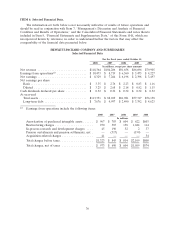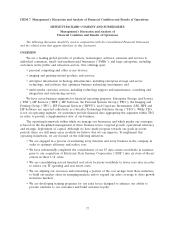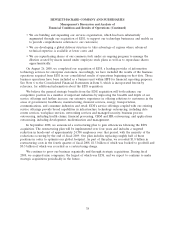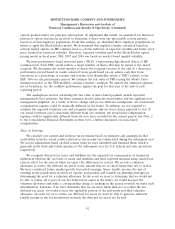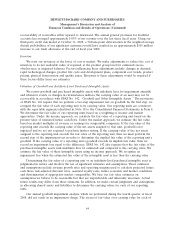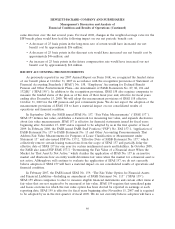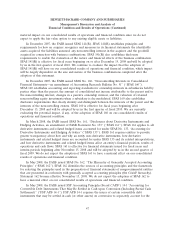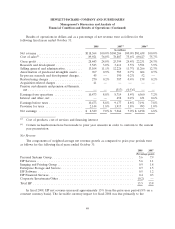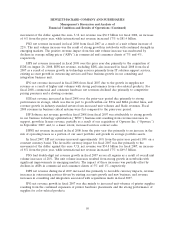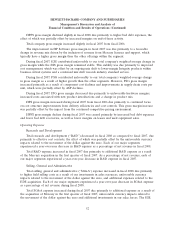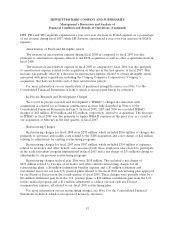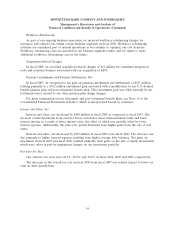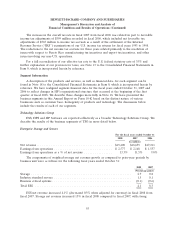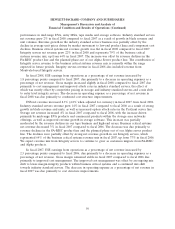HP 2008 Annual Report Download - page 52
Download and view the complete annual report
Please find page 52 of the 2008 HP annual report below. You can navigate through the pages in the report by either clicking on the pages listed below, or by using the keyword search tool below to find specific information within the annual report.HEWLETT-PACKARD COMPANY AND SUBSIDIARIES
Management’s Discussion and Analysis of
Financial Condition and Results of Operations (Continued)
same direction over the last several years. For fiscal 2008, changes in the weighted-average rates for the
HP benefit plans would have had the following impact on our net periodic benefit cost:
• A decrease of 25 basis points in the long-term rate of return would have increased our net
benefit cost by approximately $36 million;
• A decrease of 25 basis points in the discount rate would have increased our net benefit cost by
approximately $46 million; and
• An increase of 25 basis points in the future compensation rate would have increased our net
benefit cost by approximately $12 million.
RECENT ACCOUNTING PRONOUNCEMENTS
As previously reported in our 2007 Annual Report on Form 10-K, we recognized the funded status
of our benefit plans at October 31, 2007 in accordance with the recognition provisions of Statement of
Financial Accounting Standards (‘‘SFAS’’) No. 158, ‘‘Employers’ Accounting for Defined Benefit
Pension and Other Postretirement Plans—An Amendment of FASB Statements No. 87, 88, 106 and
132(R)’’ (‘‘SFAS 158’’). In addition to the recognition provisions, SFAS 158 also requires companies to
measure the funded status of the plan as of the date of their fiscal year end, effective for fiscal years
ending after December 15, 2008. We will adopt the measurement provisions of SFAS 158 effective
October 31, 2009 for the HP pension and post retirements plans. We do not expect the adoption of the
measurement provisions of SFAS 158 to have a material impact on our consolidated results of
operations and financial condition.
In September 2006, the FASB issued SFAS No. 157, ‘‘Fair Value Measurements’’ (‘‘SFAS 157’’).
SFAS 157 defines fair value, establishes a framework for measuring fair value, and expands disclosures
about fair value measurements. SFAS 157 is effective for financial statements issued for fiscal years
beginning after November 15, 2007 and is required to be adopted by us in the first quarter of fiscal
2009. In February 2008, the FASB issued FASB Staff Position (‘‘FSP’’) No. FAS 157-1, ‘‘Application of
FASB Statement No. 157 to FASB Statement No. 13 and Other Accounting Pronouncements That
Address Fair Value Measurements for Purposes of Lease Classification or Measurement under
Statement 13’’ and also issued FSP No. 157-2, ‘‘Effective Date of FASB Statement No. 157,’’ which
collectively remove certain leasing transactions from the scope of SFAS 157 and partially delay the
effective date of SFAS 157 for one year for certain nonfinancial assets and liabilities. In October 2008,
the FASB also issued FSP SFAS 157-3, ‘‘Determining the Fair Value of a Financial Asset When the
Market for That Asset Is Not Active,’’ which clarifies the application of SFAS No. 157 in an inactive
market and illustrates how an entity would determine fair value when the market for a financial asset is
not active. Although we will continue to evaluate the application of SFAS 157, we do not currently
believe adoption of SFAS 157 will have a material impact on our consolidated results of operations and
financial condition.
In February 2007, the FASB issued SFAS No. 159, ‘‘The Fair Value Option for Financial Assets
and Financial Liabilities—Including an amendment of FASB Statement No. 115’’ (‘‘SFAS 159’’).
SFAS 159 allows companies to elect to measure eligible financial instruments and certain other items at
fair value that are not required to be measured at fair value. SFAS 159 requires that unrealized gains
and losses on items for which the fair value option has been elected be reported in earnings at each
reporting date. SFAS 159 is effective for fiscal years beginning after November 15, 2007 and is required
to be adopted by us in the first quarter of fiscal 2009. We do not currently believe adoption will have a
46


